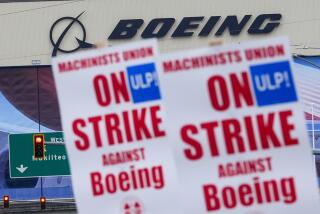Boeing Plans to Cut Up to 30,000 Jobs
Boeing Co. said Tuesday it has plans to slash up to 30,000 jobs by the end of next year, the most potent economic shock to a single U.S. corporation resulting from last week’s terrorist attacks.
The world’s largest commercial aircraft maker, reeling from one of the worst downturns in the history of the airline industry, said the prospective layoffs are in response to an anticipated sharp drop--as much as 26%--in orders over the next year for commercial airplanes.
Airlines, suffering from a slide in air travel in the aftermath of four hijackings Sept. 11, have disclosed 26,000 job cuts, but warned the losses may rise to 100,000 in the future. The financial turmoil is rapidly spreading across the economy, hitting almost every sector.
Boeing did not indicate where the cuts would be made, but the firm’s commercial aircraft manufacturing operations are centered in Seattle, with other major operations in Wichita, Kan., and Long Beach. The company this year delivered another blow to Seattle’s business establishment when it transferred its corporate headquarters to Chicago.
A Boeing spokesman said the job losses would occur “across the board,” indicating that some cutbacks would extend to support staffs and possibly noncommercial aircraft businesses. Attrition could account for some of the cutbacks, he added.
The job losses, if fully implemented, would reduce the company’s 199,000-person work force by 15%, but would represent about 33% of its commercial aircraft personnel. In a news release issued Tuesday evening, the company said it is “setting in place plans to reduce employment by approximately 20,000 to 30,000 people by the end of 2002.”
“It is critical that we take these necessary steps now to size the commercial airplanes business to support the difficult and uncertain environment faced by our airline customers,” said Alan Mulally, president of Boeing’s commercial airplanes business.
The airline industry, saying its survival is at stake, began negotiating a massive aid package with federal officials Monday.
If Boeing carries out its plan, the cuts would ripple throughout the U.S. aerospace industry and exact a heavy secondary toll in Southern California’s large aircraft subcontracting industry. The 747 jetliner’s fuselages are made in a plant in Hawthorne, for example.
“It’s a very challenging environment,” said John Dern, a Boeing spokesman, adding that the downturn seems to be far different from any other the company has faced. “We’re trying to understand it and manage our business accordingly.”
Boeing also directly employs about 5,000 workers at its 717 jetliner plant in Long Beach, where the company had already announced it would lay off about 1,200 people. Another 7,000 make the C-17 cargo jet plane in Long Beach; the Air Force program may be insulated from the cutbacks.
Boeing, which employs another 43,000 people at its space, defense electronics and communications business in California, is the state’s largest private employer.
The announcement came as the White House and Congress are considering providing federal aid to the airline industry, which has asked for $24 billion to help it escape the possibility of filing for bankruptcy.
Boeing’s outlook, announced after the markets closed, was not a surprise to analysts, who said layoffs are an inevitable side effect of the dire outlook for the airline industry. Boeing shares dropped $2.66 to $33.14 in New York Stock Exchange trading Tuesday, taking its total loss since the markets reopened Monday to 24%.
But even before the attacks, Boeing stock had been declining steadily as investors worried about a chorus of bad news from airlines hurt by a slowdown in business travel. Since May, Boeing shares have dropped more than 50% from a peak of $69.99.
With the attacks and the resulting fallout, some analysts predicted that deliveries of airplanes would shrink by 20% or more in 2002 as airlines stop ordering or cancel existing orders. The terrorist attacks could lead to a prolonged wariness by travelers, they said.
“The Sept. 11 attack on the United States may fundamentally change the investment outlook for commercial aerospace,” warned Byron Callan, an analyst with Merrill Lynch & Co.
Indeed. Boeing said Tuesday it expects to deliver 38 fewer airplanes than anticipated this year and reduced its forecast for 2002 from about 510 planes to the low 400s, with a further slide in 2003.
Amid the drop in business, Boeing may have to reconsider or postpone launching the proposed “sonic cruiser,” a new commercial jet that would fly near the speed of sound. The adverse climate also could throw into question a rival plan by Airbus Industrie to build the world’s largest commercial aircraft, the A-380.
Boeing officials had said it was likely to make a decision about its new airplane later this year. Developing a new jet could cost $10 billion, an amount not likely to be available with the airline downturn.
*
RELATED STORY
Airline squeeze: Airlines plead for immediate federal aid, warning of bankruptcies within days. A3
More to Read
Inside the business of entertainment
The Wide Shot brings you news, analysis and insights on everything from streaming wars to production — and what it all means for the future.
You may occasionally receive promotional content from the Los Angeles Times.










